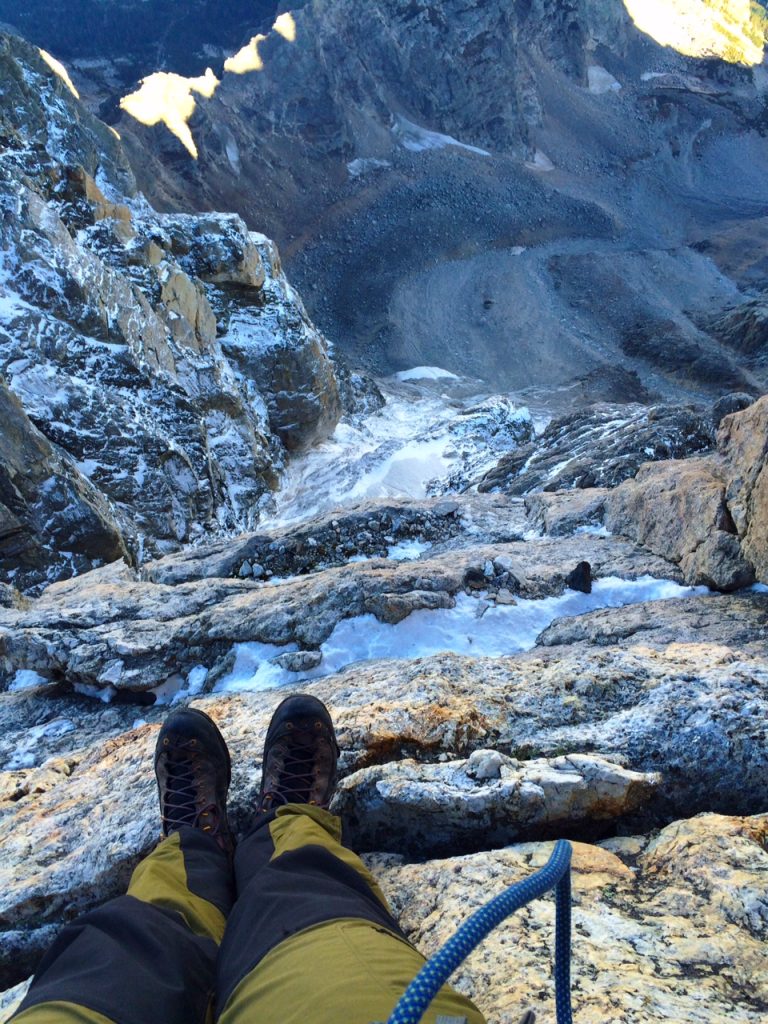
By Brenton Reagan
Lessons are learned from mistakes. Ironically, sometimes something as “unimportant” as a pizza can put your mission and life in danger. These are some mistakes I won’t make again/learned the hard way.
#1 Failing to Research the Route/Objective
On the East face of 12,330-foot Teewinot in the Tetons, I pressed on without my partner who was too tired to continue.
It was early season when the snow line was at 9500 feet.
As I reached the notch to climb onto the summit block I found that the climbing to be harder than I expected, but I could see an anchor so “I must be going the right way” – I told myself.
Upon reaching the top of the tower I realized it wasn’t the summit at all. Teewinot is notorious for this – unbeknownst to me.
With an anchor, but no rope I would have down climb, and it was super sketchy. I was stuck.
I went back up to the top of the false summit more than a few times to look for other options but found none.
So I finally worked up the “courage” to pull through the tough down climbing moves.
Prior to the attempt, I had not asked anyone for any information on the route or conditions. I just thought I knew which one was the summit.
I had no partner and no rope and after taking a long time to down climb from the tower I raced down the East Face in a hurry to get down before a major snowfield re-froze.
I also had no crampons – so crossing a steep, frozen snowfield in just approach could lead to a terrifying steep slide ride to my death on the boulders at the bottom.
Upon returning to Jackson I told my longtime friend and mentor about my adventure and he congratulated on surviving the most dangerous route in the Tetons – the East Face of Teewinot has more accidents than any other major route in the range.
Lesson: Research unfamiliar routes and objectives prior to climbing.
#2 Watch What You Eat, Stick To Routes You Know
During a one-day Grand Traverse attempt my partner and I arrived at the Lower Saddle of the Grand Teton – the halfway point – which is at 11,650 feet. We had a fellow guide leave some food at the hut for us. It was pizza.
In our fatigued and hungry state, we managed to eat all of it. As we started the second half of the traverse towards the North Ridge of the Middle Teton we knew what had made a mistake by eating too much.
We had to slow our pace – our stomachs were upset.
This compounded ….
We then decided we didn’t want to get out the rope for one of the upper sections because it would further slow us down so we decided to try a route we didn’t know but had “heard” might go without a rope.
The unknown way slowed us even more and ended up using the rope anyway.
As we were nearing the end of the Grand Traverse with only a few peaks left a thunderstorm threatened. We were in our 13th hour of climbing.
We decided to not risk the lightning and bail back into the canyon below. But, to do so we had to manage very firm steep snowfield with just a light axe and no crampons.
It was some of the scariest glissading of my life.
Lesson: Chose appropriate nutrition the mission stick with the terrain you know.
#3 Unknown Partner, Lack of Fitness, Death Calls Twice
When I got a chance in early 2002 to obtain a grant to climbing in Kazakhstan I jumped on it.
I was the 2nd of 2 climbers from the U.S. to get a chance to climb the 7,010 meter Khan Tengri.
But, I had not trained much myself, nor even met the other climber – my partner for this attempt.
We had some confusion upon the travel arrangements and he ended up 2 days ahead of me on the travel leg.
Due to some logistical problems I was stuck at base camp, 7,000 feet, for a week longer than my partner before finally arranging a heli flight to the upper glacier.
Altitude sickness hit me on the glacier. I got very sick and had no one around the help me out. My “partner” had been there a week already, acclimating.
Summit day came, and though weak, sick and tired, I went anyway.
Soon I fell far behind my partner and other climbing groups.
The group ahead managed to knock off an avalanche that just missed me as I was ascending the fix the ropes – Death’s call number one.
Later on the upper mountain as I was headed for the summit but was so tired a few hundred meters from the top I stopped to rest only to fall asleep!
A Russian climber woke me and encouraged me to head down before nightfall and death by exposure. – Death’s call number 2.
My “partner” had summited and was safely back down in the snow caves at high camp – unconcerned about my fate.
I was nearly killed at least 2 times if not more on that trip.
I didn’t know anyone and hadn’t spent any time building a relationship with the only other American on the mountain. I was not fit for the climb, nor had I adjusted to the high altitude. I did not know, and could not trust my climbing partner.
Your partner(s) on a big mountain expedition like Khan Tengri is more important than the climbing objective.
Lesson: Know, train with, and build trust with a partner prior to any expedition. Train appropriately. Don’t leave yourself at the mountain’s mercy.
About the Author: Brenton is a professional mountain guide, sponsored mountain athlete, and long-time friend and athlete at MTI.
You Might Also Like The Alpinist Assessment
